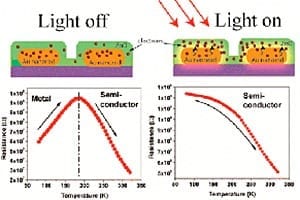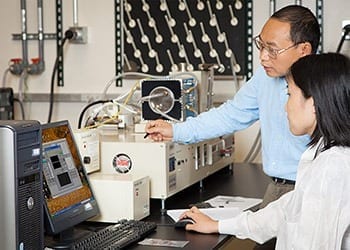
By blending their expertise, two materials science engineers at Washington University in St. Louis changed the electronic properties of a new class of materials — just by exposing it to light.
With funding from the Washington University International Center for Advanced Renewable Energy and Sustainability (I-CARES), Parag Banerjee, PhD, and Srikanth Singamaneni, PhD, both assistant professors of materials science, brought together their respective areas of research.
Singamaneni’s area of expertise is in making tiny, pebble-like nanoparticles, particularly gold nanorods. Banerjee’s area of expertise is making thin films. They wanted to see how the properties of both materials would change when combined.
The research was published online in August in ACS Applied Materials & Interfaces
The research team took the gold nanorods and put a very thin blanket of zinc oxide, a common ingredient in sunscreen, on top to create a composite. When they turned on light, they noticed that the composite had changed from one with metallic properties into a semiconductor, a material that partly conducts current. Semiconductors are commonly made of silicon and are used in computers and nearly all electronic devices.
“We call it metal-to-semiconductor switching,” Banerjee said. “This is a very exciting result because it can lead to opportunities in different kinds of sensors and devices.”
Banjeree said when the metallic gold nanorods are exposed to light, the electrons inside the gold get excited and enter the zinc oxide film, which is a semiconductor. When the zinc oxide gets these new electrons, it starts to conduct electricity.
“We found out that the thinner the film, the better the response,” he said. “The thicker the film, the response goes away. How thin? About 10 nanometers, or a 10 billionth of a meter.”
Other researchers working with solar cells or photovoltaic devices have noticed an improvement in performance when these two materials are combined; however, until now, none have broken it down to discover how it happens, Banerjee said.
“If we start understanding the mechanism for charge conduction, we can start thinking about applications,” he said. “We think there are opportunities to make very sensitive sensors, such as an electronic eye. We are now looking to see if there is a different response when we shine a red, blue or green light on this material.”
The Latest Bing News on:
Metal-to-semiconductor switching
- China's Semiconductor Spending Tops US With $142B Commitment: Global Chip Race Heats Upon May 13, 2024 at 1:07 pm
Western governments prioritize securing chip supply to compete with China, as seen through Biden's $32.8B incentives, export restrictions, and ASML concerns.
- AOSL Alpha and Omega Semiconductor Limitedon May 7, 2024 at 9:00 am
It offers power discrete products, including metal-oxide-semiconductor field-effect ... In addition, the company offers 650V SiC MOSFET, a switching solutions for solar inverters, motor drives ...
- Semiconductor substrate behaves ‘like the tail wagging the dog’, say scientistson May 2, 2024 at 5:00 am
According to the researchers’ theoretical calculations and modelling, this mechanism involves atomic sites in the material lattice that are missing oxygen atoms. These native oxygen vacancies, as they ...
- Compound Semiconductor Market CAGR of 11.3%, Share, Analysis, Size, Prominent Players, and Forecast 2024 to 2032on April 28, 2024 at 2:27 pm
The global compound semiconductor market was valued at $66,623 million in 2016, and is expected to reach $142,586 million by 2023, registering a CAGR of 11.3% from 2017 to 2023. Compound ...
- Research Bits: April 16on April 15, 2024 at 5:00 pm
Alongside the memristor’s electrical resistive switching, a thermal resistive switching ... to the semiconductor material on top of it when the semiconductor switches between an insulator and a metal.
- Alpha and Omega Semiconductor Introduces a 20V, 7A Type-C Sourcing Protection Switch Designed to Enhance USB Type-C Efficiency and Safetyon April 11, 2024 at 4:59 am
Alpha and Omega Semiconductor Introduces a 20V, 7A Type-C Sourcing Protection Switch Designed to Enhance USB Type-C Efficiency and Safety The advanced features of the AOZ1377DI capable to support ...
- Alpha and Omega Semiconductor Introduces a 20V, 7A Type-C Sourcing Protection Switch Designed to Enhance USB Type-C Efficiency and Safetyon April 11, 2024 at 1:00 am
--(BUSINESS WIRE)--Alpha and Omega Semiconductor Limited (AOS ... today announced the release of its AOZ1377DI Type-C Protection Switch. Designed to enhance USB Type-C efficiency and safety ...
- 'Surprising' hidden activity of semiconductor material spotted by researcherson April 4, 2024 at 8:01 am
The researchers worked with the semiconductor material ... such as vanadium dioxide, that can switch between metal—the one state—and insulator—the zero state—states in a trillionth ...
The Latest Google Headlines on:
Metal-to-semiconductor switching
[google_news title=”” keyword=”metal-to-semiconductor switching” num_posts=”10″ blurb_length=”0″ show_thumb=”left”]
The Latest Bing News on:
A new class of materials
- Failure of CBA class actions sets new standardon May 12, 2024 at 7:12 am
Nobody can reliably establish what information influences the prices at which anyone buys or sells shares, or the reasons anyone trades in shares at a point in time is the essence of a landmark ...
- Geomagnetic storm begins. Will the northern lights be visible in New England?on May 10, 2024 at 8:16 pm
It is an almost certainty that the northern lights will be very active overnight Friday through early Saturday.
- New Organic Material Outshines Traditional NIR Detectorson May 10, 2024 at 8:06 am
Recently, in the Chinese Journal of Polymer Science, researchers at the South China University of Technology discovered a novel class of infrared photodetectors based on organic semiconductors and it ...
- New phononics materials may lead to smaller, more powerful wireless deviceson May 9, 2024 at 2:23 pm
What if your earbuds could do everything your smartphone can do already, except better? What sounds a bit like science fiction may actually not be so far off. A new class of synthetic materials could ...
- Which states passed new election laws in 2024? Check to see if your state made changeson May 9, 2024 at 1:20 pm
A range of new voting laws throughout the U.S. could offer insights as to how ballot access could influence Election Day outcomes.
- New patent for bio-based polymer to be used in piezoelectric deviceson May 7, 2024 at 12:07 pm
UD engineers are the lead inventors on a new patent for making piezoelectric devices, such as sensors and actuators, using Nodax, a biodegradable, bio-based polymer.
- Researchers establish commercially viable process for manufacturing with promising new class of metalson May 7, 2024 at 12:06 pm
Nanostructured high entropy alloys—metals made from a chaotic mix of several different elements—show a lot of promise for use in industries such as aerospace and automotive because of their strength ...
- New class of spongy materials can self-assemble into precisely controllable structureson April 30, 2024 at 8:02 am
A team of researchers led by the University of Massachusetts Amherst has drawn inspiration from a wide variety of natural geometric motifs—including those of 12-sided dice and potato chips—in order to ...
- Matchbox Launches New Mercedes-Benz Die-Cast Car to Celebrate the Reveal of the All-New Electric G-Classon April 30, 2024 at 12:02 am
(NASDAQ: MAT) announced the Matchbox® Mercedes-Benz G 580 with EQ Technology die-cast car. The new die-cast vehicle was created to celebrate the iconic Mercedes-Benz G-Class and the recent reveal of ...
- Creation of Novel Material Could Lead to New Line of Quantum Researchon April 10, 2024 at 5:00 pm
Professor James Rondinelli, Research Assistant Professor Danilo Puggioni, Lauren Walters (PhD '22) Recent work from Northwestern Engineering’s James Rondinelli could lead to a new class of metals that ...
The Latest Google Headlines on:
A new class of materials
[google_news title=”” keyword=”a new class of materials” num_posts=”10″ blurb_length=”0″ show_thumb=”left”]










